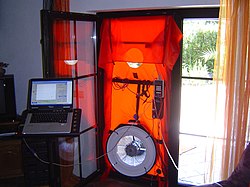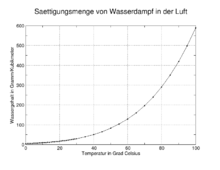Air exchange

In building physics , air exchange is defined as the ratio of the air volume flow, i.e. the volume of the air exchanged during ventilation , to the volume of the ventilated room.
The amounts of air change are dimensionless as a ratio of two volumes. The air change per unit of time is referred to as the air change rate . An air exchange rate of 1 / h means that the volume flow of the supply air is just one room volume per hour:
Due to the mixing of the fresh air with the existing room air, however, the room air is not completely renewed with an air change of 1. The relationship between the “actual air renewal” and the air change is a characteristic parameter for the selected ventilation concept and is referred to as ventilation efficiency .
In Germany, various standards and guidelines require minimum air changes depending on the use of the structures. For example, DIN 4108-2 requires a basic air change of n = 0.5 / h in residential buildings with constant ventilation and n = 4 x A G / V x [1 / h] with A G : floor area in m 2 and V the net room volume, required in m 3 . 4 ventilation levels are defined in DIN 1946-6: ventilation for moisture protection, reduced ventilation, nominal ventilation and intensive ventilation. The resulting volume flows depend on the living space and the number of sanitary rooms as well as the number of users.
Sample calculation: living room for 4 people
The air quality in living spaces is significantly affected by odor and pollution from body vapors, tobacco smoke, water vapor (caused by human activities in the kitchen, in the bathroom or by watering indoor plants), fecal and kitchen odors and vapors from furniture, building materials and textiles . In order to comply with the hygienic requirements, defined air volume flows are supplied to the living space. If there are no noticeable smells in the apartment, inadequate air exchange is often reflected in excessively high humidity .
A family of 4 releases around 10 liters of water per day. This water is distributed over 100 m 2 of living space and a room height of 2.5 m to 250 m 3 of air. The following is an example of how this water can be removed by a suitable minimum air change so that, for example, mold formation can be prevented.
At an air temperature of 20 ° C, 1 m³ of air can absorb a maximum of 17.3 g of water vapor. At a relative humidity of 50% it is 8.7 g. By ventilating at an assumed 4 ° C and 80% rel. Fresh air has a humidity of 6.4 g / m³ with saturation and 5.1 g / m³ with the assumed humidity.
One cubic meter of fresh air should take in water with the assumed numbers . In order to discharge 10 l of water, 2833 m³ (10,000 / 3.5 = 2,857 m³) of air per day have to pass through the apartment, corresponding to 11.3 air changes or an air change rate of about 0.5 / h.
A completely joint-tight house would have to be ventilated 11 times a day. If one assumes an air exchange rate of 9–15 for the intermittent ventilation, one hour must be intermittently ventilated , with cross ventilation (air exchange rate 40) correspondingly around 17 minutes.
This number is reduced to 7 ventilation processes under otherwise identical conditions, assuming a humidity of 65%. Because the air in the room can absorb water vapor at 65% , more water vapor per cubic meter can be transported outside than at 50% rel. Humidity. The necessary air exchange can be further reduced by specifically ventilating after cooking and bathing, because if the humidity is only briefly increased, no mold will form.
See also
Individual evidence
- ^ A b Hermann Recknagel, Eberhard Sprenger, Karl-Josef Albers (eds.): Pocket book for heating and air conditioning . 79th edition. Vulkan-Verlag, 2018, ISBN 978-3-8356-7405-9 , pp. 1912 .
- ↑ DIN 4108-2 Thermal insulation and energy savings in buildings - Part 2: Minimum requirements for thermal insulation . Beuth Verlag, February 2013, p. 30 , para. 8.4.2 Calculation boundary conditions for thermal building simulation calculations, point g) ( beuth.de ).
- ↑ DIN 1946-6 Ventilation technology part 6: Ventilation of apartments - General requirements, requirements for dimensioning, execution and labeling, handover / acceptance (acceptance) and maintenance . Beuth Verlag, December 2019 ( beuth.de ).





